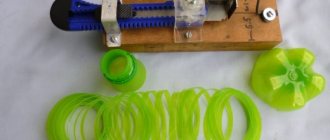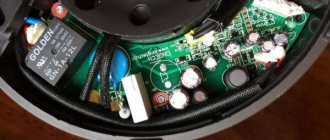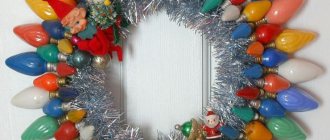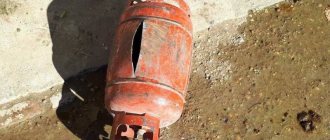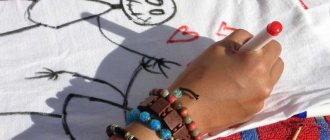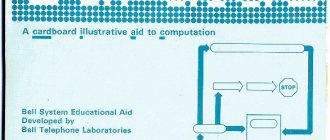Burying
The first thing you can do is turn the cartridge over with the nozzles facing up and apply a few drops of cleaning liquid to them. Not everyone has the latter and is much more expensive than window cleaner, which can also be used. Experts recommend blue Mister Muscle .
Leave for 5-10 minutes. We wipe everything. Press the nozzles onto toilet paper or a napkin and check the print (see the first photo in this article). If the print is unclear or is not there at all, move on to the next step.
Soaking
Take a lid from a jar and pour a cleaning liquid into it (suitable for windows) a few millimeters high.
Place the cartridge with nozzles in the liquid and leave for 1 or 2 hours (see photo on the right). We take it out, wipe it and check the ink print. If the print is not clear, change the cleaning liquid in the lid and leave it for 1 day. To prevent the liquid from evaporating, you can cover it with some kind of plastic container or change the liquid every 6 hours.
Checking the nozzle print. If the latter does not suit us, then we refill the cartridge with a cleaning agent. For internal use, I would buy a special one. Place the nozzles in the lid with cleaning liquid and leave for 1 day.
We take out the cartridge, wipe it and use a syringe to pump out the liquid inside. Refill with ink and check the print. If the latter leaves much to be desired, then move on to the next method.
Pressure
You can pressurize the cartridge chamber to force ink through the nozzles and clear them. To do this, use pliers to break off part of the syringe needle so that a piece 1-2 cm long remains. Find a piece of elastic. You can cut off a piece of the eraser. We put a rubber band on the shortened syringe needle. This will be our seal. We fill the syringe with air.
Place the cartridge on a napkin or toilet paper. The nozzles must be free. Insert the needle into the filling hole and press down. A piece of eraser will seal the hole. We press in the piston.
Ink should come out through the nozzles. If all else fails, you can try removing the cartridge cover (see video below), pull out the foam and fill in the flushing liquid. Lower the nozzles into the lid with the flushing liquid. We close the whole thing and leave it for 1 day. If it doesn’t help, then you need to think about buying a new one.
To prevent the ink from drying out, it is recommended to either print regularly and refill it on time, or, if you are leaving for a long time, remove the cartridges from the printer and seal it tightly in a small container.
The ink cartridge may dry out due to the printer being idle for a long time or as a result of untimely refilling. Manufacturers of inkjet printers are categorically against any manipulation of cartridges (except for their complete replacement), but in most cases this expensive procedure can be avoided.
Recovery methods
If this procedure does not help the first time, you can repeat it or try another recovery method.
The recovery process for black and color cartridges with built-in print heads is the same, but it is easier to restore a black cartridge than a color one, because If it contains one color, then the chances of getting a positive result are greater.
Reasons for the failure of printing devices
Each user can understand the concept of poor laser printer printing in his own way. Therefore, each of the options for such low-quality printing should be highlighted. If you begin to notice vertical black lines or gaps along the edges, and they increase each time, then most likely the cartridge photo roller has failed.
After prolonged use and several refilling sessions, black stripes appear at regular intervals on sheets of paper. This type of bad printing indicates an overfilled waste toner bin. According to the instructions, it should be cleaned after each refueling. If you don’t do this, then the result is known.
Missing text, white spots, and faint printing are the causes of wear on the magnetic roller. After prolonged use, its surface wears out and can no longer fully apply powder. Such a part needs to be replaced, which should not be postponed so as not to aggravate the situation and damage other parts. It would also be useful to check the contact between the magnetic and photo shafts.
Most printing equipment does not have time to serve the warranty period and requires repair. This applies mainly to the failure of the print heads of inkjet printers. But many printers last well longer than the manufacturer expects. Not all users want to get rid of expensive equipment for the sake of fashion, but replacing worn parts is still necessary.
Rice.
1. Printer repair Common printer problems
| Printers based on printing technology | Possible faults |
| Dot matrix printers | Print head, restoration is not possible. Reason: mechanical shock absorption of moving parts. |
| Print head cable, replacement only. Reason: loss of flexibility, aging. | |
| Paper path, restoration or replacement. Reason: depreciation of mechanical parts or damage to the tract by foreign objects. | |
| Inkjet printers | Print head or cartridge with PG, restoration or replacement. Reason: incorrect carriage parking, long pauses in use, bad or unsuitable ink, unskilled user actions. |
| Paper path, repair or replacement. Reason: foreign objects in the path, use of inappropriate paper, wear of mechanical parts. | |
| Head cleaning unit, replacement or repair. Reason: frequent cleaning of the PG, increased use and frequent replacement of cartridges. | |
| Contamination of surfaces, components and mechanisms of the device with ink and dust. | |
| Laser printers | Paper path, restoration or replacement. Reason: depreciation of parts, ingress of foreign objects, incorrectly selected paper. |
| Image transfer unit, restoration or replacement of parts. Reason: damage to the photosensitive drum or laser unit. | |
| Image fixing unit, repair or replacement. Reason: violation of the integrity of the thermal film on the photo drum, damage to the fuser (fuser) or its control unit. | |
| Contamination of printer mechanisms and components with dust and toner. |
READ MORE: How to make a vice with your own hands? Drawings with dimensions
When workshop repairs are needed
Detecting a printer failure causes panic for most users. Most often, such equipment owners immediately begin to call a repairman, without even really understanding what happened to the device. Before rushing to the phone, you need to check:
- power supply connection: the cable itself, a key on the printer, energy saving mode;
- paper availability: the absence of paper is displayed on the printer panel and monitor screen, check the correct paper tray and paper size selected;
- additional printer connections: reliable contact of the USB cable with the computer; the network printer is used to check the presence and functionality of the network;
- correct print address: when changing printers, you need to control the sending of print jobs to the connected printer;
- consumable life: the end of the life of one of the ink cartridges results in printing being blocked.
If everything listed is in order, then you can call a technician and repair the printer at home. When filling out an application, it is necessary to convey as accurately as possible what model the device is and what exactly happened to it. Since repair of inkjet printers can only be done in a workshop.
Laser printing technology has large resources for producing basic blocks and mechanisms. But there is no escape from wear parts. Therefore, repair of laser printers and their cartridges is a common occurrence.
Method 1. Soaking
If the cartridge with a sponge inside dries out, you should try to soak the sponge. To do this, place the cartridge in a vessel filled with distilled water or washing liquid with the nozzles down (in the same position as it is installed in the printer). Soaking can take quite a long time (from several hours to several days.) It is important to pour little water so that only the nozzles are immersed in it (to a height of about 1 cm). Then the cartridge is filled with ink. It doesn't hurt to pump the ink through the suction cup with a syringe, but don't use too much force. Pull the syringe slowly, without sudden jerks, and when the ink begins to come out evenly and in large quantities (no more than 10 ml), it is better to stop the procedure. Before inserting the cartridge into the printer, wipe it clean of any remaining ink, and pay special attention to the electronics contacts. Do 2-3 head cleanings and print a test page.
Method 2. Boiling or 'the principle of boiling pasta'
- small iron bowl or ladle
- pliers and pliers
- napkin or toilet paper
Instructions
- With the printer turned on, open the lid and wait. and the cartridges themselves move to the replacement position. It is enough to lightly press its box down and it will come out easily. We take out the cartridge
- Now you need to heat a small amount of water on the stove in an iron bowl or ladle so that the water boils and steam comes out. We take the cartridge and hold the print heads over the fumes, you can rinse for 2-3 minutes by lowering the print cartridge into boiling water. Be careful because... The cartridge will heat up, so it is better to hold it with pliers. Just do not squeeze it under any circumstances to avoid damage.
- The dried paint in the head should become wet and begin to drip; wipe off all excess with napkins until all the colors come through. This can take quite a long period of time, depending on the degree of neglect of the printing nozzles.
- If the inkjet cartridge has not been used for a long time, you will have to wash it from the inside. Be careful when opening the lid. Older models have a special metal device for this. Don't be afraid of a little crunch, you can't do without it. On new printers, the cover is sealed with adhesive tape; first you need to get rid of it, and then carefully open it with a screwdriver. The main thing is to prevent cracking of the walls, this can render the container unusable. We take out the absorbent inserts and rinse them with warm water, be sure to remember where each of them was located.
Disassembling the printer oven to access the thermal film
Unscrew the two screws securing the top cover of the stove. Remove the cover by pulling it to the side.
First cover screw
Second cover screw
The stove cover has been removed
Now we see the destruction of the thermal film. Remember the position of the bars with clamps and levers!
There are springs on the sides of the stove; we unhook the springs from below with long-nose pliers.
We remove the metal strips and plastic clamping levers on each side. Do not mix them up when assembling!
Thermal film destruction
Paper clip price
Lever mounting spring
Remove each spring
Removing the slats
Having gained access to the drum, we continue the repair.
Method 3. Steaming
You take a dead, dead cartridge from an inkjet printer, which has been lying around no matter how long and has dried up tightly and all sorts of soaking, blowing, and ultrasonic baths do not help and everyone says throw it away and buy a new one - try this method and everything will work. This method applies to HP, Canon, Lexmark cartridges with a built-in print element. Take a kettle, boil water, when it boils and pour it into some bowl, the water depth is about 1 cm in and immediately lower the dried cartridge into this boiling water with the nozzles downwards, just before that remove the top sticker covering the holes as the paint will expand greatly and can flow out through top filling holes, hold in boiling water for 30 seconds and do this three times (carry out all operations with a refilled cartridge). Then you wipe the cartridge nozzles with a napkin and put some photo into the printer to print at the best quality, it will immediately turn out to be anything, then you make 4 main color sheets completely of the same color and print to run each color, the quality will still not be very good for In order to eliminate this, print any photo and in the printer settings set the quality to normal (not fast, not draft, but REGULAR). I would be most grateful if you leave a review here; I would also be grateful if you recommend this site to your friends.
Method 4. Under running hot water
Sometimes it happens that the cartridge head becomes clogged or dries out. In an attempt to clean the head, you have tried many methods for cleaning cartridges, but none of them helped you. I found another way to clean (restore) the ill-fated cartridge. To do this, you do not need to buy anything additional, such as “Liquid for cleaning cartridges”, “Special devices”, etc. To do this, take the cartridge and place it upside down in the bath, head up. Next, turn on the hot water, with a small stream of water. This stream should accurately fall on the head with nozzles. Thus, the cartridge should stand for a couple of minutes. The cartridge needs to be moved a little so that the falling stream of water hits all the nozzles. The meaning of this method of cleaning printing elements is as follows. Water falling from a height of about a meter picks up speed and passes with force through the nozzles (holes through which ink splashes onto the paper during printing) and cleans them. The jet also breaks through dried channels that you had previously resisted. After this procedure, close the tap, take the cartridge and place it head down on a cloth and let it dry. Wipe it down and put it in the printer. Print a test page. If you are not lucky the first time, repeat the procedure several times.
If these methods do not help you, see more material on cartridge recovery below
Possible faults
The most common printer cartridge problems include:
- drying of ink on print heads;
- failure of the photo shaft;
- squeegee failure.
The first problem is most often encountered by owners of inkjet printers. The solution is quite simple: to dissolve the paint, pour a little alcohol into a saucer (you can use vodka) and lower the cartridge head down into the liquid.
After 2 hours, you need to take an empty syringe and pull back the plunger. The medical instrument should be inserted into the hole intended for refilling the dye, and by sharply pulling the piston, clean the print head. Refilled cartridges are installed in place by selecting the cleaning mode in the settings. Cleaning should be done several times, then try to print. If there are problems, the equipment settings are reset and then tried again. If there is such a need, then the cleansing is repeated.
This laser printer printing part is more difficult to repair. The first step is to determine the nature of the malfunction. If the cartridge is functioning and has enough ink, but blots and streaks form during printing, then the problem is most likely with the drum or squeegee. The latter removes excess toner from the photosensitive drum.
Method 5. Cleaning the cartridge in an ultrasonic bath
'Fari' and water are used. Color water-based ink cartridges recover after 10 years in the cabinet.
We also recommend reading:
Published: September 17, 2007 Last modified: August 18, 2013
Inkjet printers are characterized by low cost and excellent color printing quality. However, these devices have one common drawback - the rapid drying of any ink in the cartridge. This leads to a change in the quality of the printer and even a complete lack of printing. If the cartridge is dry, what should I do?
The cartridge has dried out: what should the user do?
The fastest and most reliable way to solve the problem is to purchase a new cartridge. If your device is dry, you can contact a service center where you will receive professional help. You can try to restore the printer using the forced cleaning mode.
You can try to solve the problem of resuscitating a cartridge yourself using several effective methods. But it will take time and, of course, you will have to put in some effort. In addition, you need to take into account that this is quite dirty work - then you will have to wash your hands and work area.
To implement one of the methods of cleaning the cartridge, you need to purchase washing liquid and a syringe with a needle, prepare paper towels and a small container with a lid.
It is necessary to determine the degree of drying of the ink: turn the unusable cartridges with the print heads up and drop washing liquid from the syringe onto them. If the composition is absorbed through the nozzles, this means that the restoration process will be short-lived.
Recovery
What to do if a Canon or HP cartridge is dry? In this case, it is necessary to dissolve the remaining ink and clean the nozzles. In order to pour the purchased washing liquid into the cartridge, you need to carefully peel off the label with the number. Under it you can see special holes. Then fill the foam adsorber with washing liquid from a syringe.
For a color cartridge you will need 5 milliliters of the composition, for a black cartridge - 10 ml. The remaining special cleaning fluid must be poured into an empty container. The cartridge should be installed in it with the nozzles facing down. Close the container with a lid and leave the cartridge to soak for 24 hours.
After a day, pump out the solution with remaining ink using a syringe. Then you can begin refilling the cartridge and then installing it into the printer. Enable forced cleaning mode and print a test page. If the user is not satisfied with the print quality, he can repeat soaking the cartridge in any container with washing liquid.
Turning off economy mode
The user, through ignorance or carelessness, can turn on the printer's economy mode. But such a switching of settings can also happen automatically by the device itself. In some models, when the level of powder or ink is low, a similar mechanism is built into the behavior algorithm. This fact is worth checking first, since correcting it is much simpler than other methods of “curing” bad printing.
- Open a list of all connected printers through the Quick Launch window (Windows R). In the prompt, enter "control printers".
- Find your model and open Print Settings.
- In the window that opens, on one of the tabs you will be able to change the print quality, which can be easily changed to suit your needs.
Pressure
There are situations when a user is in a hurry to print a document, turns on the printer and discovers that the HP cartridge is dry. What to do if you don’t have cleaning products on hand? You can wash the nozzles with ink. To do this, it is necessary to create pressure inside the cartridge. The user needs to use pliers to break off part of the needle so that 2 centimeters of metal remains on the syringe.
Next, you should cut a small piece from the elastic band or eraser. Place the homemade seal on a shortened needle and draw air into the syringe. Place the cartridge on a napkin with the nozzles facing up, insert the needle into the refill hole and squeeze the air out of the syringe. In this case, the piece of eraser should completely cover the filling hole. Ink will come out through the nozzles.
Types of toners
Any such device is refilled with a toner powder specially designed for this purpose. This dry black mixture is produced from oil waste. The important thing is that different printer models use different toners . This color mixture is based on technology developed for a specific brand.
The powder for the cartridge should be selected strictly according to the labeling of a particular printer or MFP model.
Among laser printer toners, several categories can be roughly distinguished.
- Original toner. It is located inside a branded cartridge and is suitable for a specific printer model. You can order this color mixture only at large chemical plants of well-known manufacturers. For most brands (for example, Samsung and others) you cannot buy such material. However, there are no exceptions without rules: for example, it is quite possible to purchase such a cartridge for OKI, Lexmark and Canon.
- Much more often, refueling specialists use compatible options. But here you also need to look at the organization offering its services: for example, Uninet, Katun, Colortek, Hi-Black do this for HP printers. Many compatible toners are mistakenly called universal.
- The most unscrupulous option is counterfeit toner. Externally, the packaging and design will be an exact copy of the original consumable, but inside there is a powder produced in violation of the prescribed standards or even intended for a different brand.
Dry cleaning
There are three types of compounds:
- Acid. Consists of 10% acetic acid essence, 10% alcohol, 80% distilled water. Suitable for HP color printers.
- Neutral. Consists of 10% glycerin, 10% alcohol, 80% distilled water. Can be used for cleaning any cartridges.
- Alkaline. Ingredients: 10% ammonia, 10% alcohol, 10% glycerin, 70% distilled water. Suitable for Canon and Epson printers.
The user can prepare the appropriate composition himself if he discovers that the cartridge has dried out. What to do with homemade cleaner?
The liquid must be poured onto a paper towel. Place the cartridge with the nozzles down on a napkin with a special composition. Wait 2 days. The empty cartridge can be placed entirely into the solution. It is worth noting that foam filler cannot be immersed in the composition.
Removing damaged thermal film from the drum
Release the white wires from the clips and remove the drum with thermal film. It just goes up.
Removing the thermal drum
Thermal drum has been removed
We disconnect the plastic tip from the side where the thin wires come out of the drum. The cap is held on by clips.
Remove the cap
We remove the damaged thermal film and wipe the metal surface and thermoelement with a damp cloth to remove old grease and dirt.
Removing the thermal film
Wipe the drum
Now everything is ready to install the new thermal film
Alternative methods
Many users get upset when they find that their ink cartridge is dry. What should I do if I cannot restore normal print quality using the above methods? A completely unusable cartridge can be placed in the bath with the nozzles facing up. Then you should open hot water. A small stream should fall directly onto the print head.
The cartridge should be moved so that the water passes through all the nozzles. The jet will wash dry holes that were not amenable to regular cleaning. After 2 minutes you need to close the tap. After this, you need to place the cartridge on a piece of cloth with the nozzles down, let it dry, wipe it thoroughly with a napkin and install it in the printer. Print a test page.
How to calibrate inkjet printers
Printhead calibration is not a complicated process. But it requires accuracy and consistency of actions from the user. To get a calibrated printer, use a utility called “Print Head Calibration”. Keep in mind that it will not start if the printer is busy printing documents. To align the print heads, first turn off the printer and set the paper thickness adjustment lever to the standard position. Then place several sheets of paper in the tray.
On some printers and MFPs, print head calibration can be started directly from the device menu. To do this, press the button with which you can set the number of copies and, while holding it, press the power button of the device. Following these steps will allow you to print calibration pages. On the first sheet of paper, the device will leave several rows, which will be necessarily numbered. You should choose the template in which the two lines match each other as much as possible. Then click on the button that allows you to specify the number of copies and enter the number of this template. Next, select “Copy Black and White” and, having confirmed your choice, repeat the steps described above for all pages, the number of which will be equal to four. It is better to familiarize yourself with the procedure for starting calibration of your printer model in the user manual, because The startup process may differ on different devices.
On some printers, you may need to print a calibration sheet from your computer to align the printheads. It is necessary to ensure that the print settings are correct. The calibration scheme is the same as in the case of calibration on the device without the participation of a computer. We print, select one sample (the least grainy) in each resulting column and enter their values in the appropriate fields. If you fail to select the optimal sample, then give preference to the most suitable one and click on “Recalibrate”. The device will then print a new table.
Preventing cartridge drying out
If none of the recovery methods help, then the user will have to purchase a new replacement ink unit.
What measures should be taken to prevent the cartridge from drying out? What should I do for this?
- Print the drawing weekly to control the availability of all colors.
- Do not keep the printer near a heater, in a draft, or in the sun.
Do not cover the nozzles with tape or adhesive tape. If the printer will not be used for a long time, it is recommended to close all covers of the device. Replacement cartridges should be stored in a cool, dark place.
